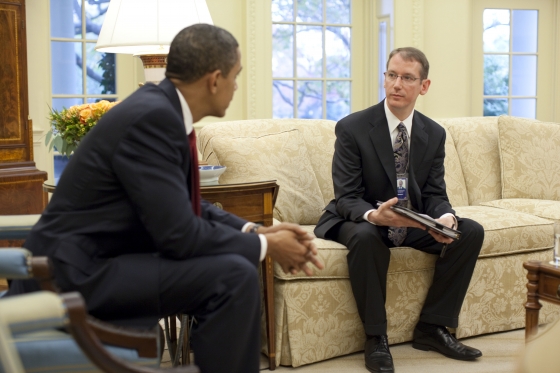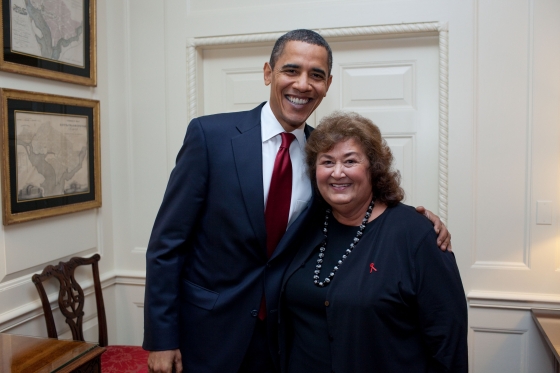-
October 31, 2009
02:30 PM EDTEarlier in the week, President Obama announced the largest-ever investment in the nation’s electric grid—more than $3.4 billion in grants distributed among 100 grantees. Though the immense scale of the investment was clear during the President’s announcement, the flood of reports from news outlets across the country has been overwhelming. A sample of those stories are linked below, detailing new projects in South Dakota, Vermont, California, and several other states:SRP gets $56.9M boost from feds for customer 'smart meters’: Salt River Project will receive a $56.9 million grant from the federal Recovery Act to speed up the installation of "smart meters" for customers, the Energy Department announced Tuesday.SMUD receives $128M in smart-grid funds: The Sacramento Municipal Utility District has been awarded $127.5 million in federal economic stimulus funds that will go toward a $308 million smart-grid infrastructure investment.7 Florida utilities and tech firm to receive $264 million: Energy grants announced Tuesday by President Obama include $264 million for seven Florida utilities and an Orlando technology company, with each grant requiring final negotiations and matching contributions.$200 million in stimulus funds flows to Georgia to update power grid: More than $200 million in federal stimulus money is expected to flow into projects in Georgia as part of the Obama Administration's plans to upgrade the nation's aging electric grid.Five New England states land $226M for smart meters: At least 832,000 smart meters will be installed across New England as a part of smart grid projects receiving funding from the U.S. Department of Energy’s Smart Grid Investment Grant funding.Federal funds granted for BGE’s smart grid: Baltimore Gas & Electric Co. expects customer costs for its smart grid projects to decrease after winning a $200 million grant from the federal government Tuesday, the company said.Edison, Whirlpool to get stimulus money: Detroit Edison and the Whirlpool Corporation in Benton Harbor will receive $103 million in federal stimulus money to make investments in green technology.Peco Energy gets $200M ‘smart-grid’ grant: Peco Energy Co. was awarded a $200 million federal stimulus grant today that will allow it to speed up deployment of "smart-grid" technology, including 600,000 advanced electric meters in the next three years.Two S.D. power companies to share $9M in federal funds to install smart meters (video): Black Hills Power and Sioux Valley Southwestern Electric Cooperative will share in more than $9 million in federal funding to help modernize the nation’s electric system.Powerful energy Vermont plan for ‘smart’ meters getting $69M: A Vermont plan to install electricity smart meters and other technologies to improve energy efficiency and reduce energy costs will receive nearly $70 million in stimulus money.Smart' grid stimulus funds come to Wyoming: Two Wyoming electric utilities will receive more than $7.5 million combined in federal grants to help modernize their infrastructure. -
While there is nothing to celebrate until job numbers turn around, the President cites the recent dramatic turnaround in gross domestic product as a sign of better things to come. He also applauds the fact that the Recovery Act has now created or saved more than a million jobs.
-
October 30, 2009
05:39 PM EDTToday, President Obama signed the Ryan White HIV/AIDS Treatment Extension Act of 2009. It represents our ongoing commitment to ensuring access to needed HIV/AIDS care and treatment. The White House and the Department of Health and Human Services (HHS) worked very closely with Congress on this bipartisan legislation, and the consensus document developed by the HIV/AIDS advocacy community was an important part of the process. We were so pleased that Jeanne White-Ginder, Ryan White’s mother, was here at the bill signing.
The Ryan White Program is the largest federal program specifically dedicated to providing HIV care and treatment. It funds heavily impacted metropolitan areas, states, and local community-based organizations to provide life-saving medical care, medications, and support services to more than half a million people each year: the uninsured and underinsured, racial and ethnic minorities, people of all ages.
The President also announced today the elimination of the HIV entry ban. Since 1987, HIV-positive travelers and immigrants have been banned from entering or traveling through the United States without a special waiver. In July 2008, Congress removed all legislative barriers to repealing the ban and paved the way for HHS to repeal the ban. A final rule will be published in the Federal Register on Monday, November 2nd and will take effect in early January 2010. That means that people who have HIV and are not U.S. citizens will be able to enter the U.S. starting in January next year. This is a major step in ending the stigma associated with HIV.
While I have been traveling across the country during the past several weeks for our HIV/AIDS Community Discussions, I am hearing from people living with HIV, nurses, case managers, doctors, community-based service providers, and others about how important the program is to ensure access to care and treatment. As we continue our work on developing the National HIV/AIDS Strategy, we have many important lessons from the Ryan White Program for increasing access to treatment, helping retain people in care, and improving health outcomes. Addressing the epidemic in the U.S. is a priority for President Obama, and we are renewing our focus on prevention as well as treatment.
As we prepare to mark the 20th anniversary of the Ryan White Program next August, the legacy of Ryan White continues to endure.
Participants at the event:
- Jeanne White-Ginder, Ryan White's mother
- Senator Tom Harkin, D-IA
- Senator Mike Enzi, R-WY
- Senator Tom Coburn, R-OK, not confirmed
- Representative Henry Waxman, D-CA
- Representative Frank Pallone, D-NJ
- Representative Joe Barton, R-TX
- Speaker Nancy Pelosi, D-CA, not confirmed
- Ernest Hopkins, Policy Chair, Communities Advocating for Emergency AIDS Relief (CAEAR); Federal Affairs Director, San Francisco AIDS Foundation
- Frank Oldham, Jr., President and CEO, National Association of People with AIDS (NAPWA)
- Julie Scofield, Executive Director, National Alliance of State and Territorial AIDS Directors (NASTAD)
More photos from the event:
Jeffrey Crowley is the Director of the Office of National AIDS Policy and Senior Advisor on Disability Policy at the White House
-
Earlier this month, I joined the President in New Orleans for his first visit there since the election. A key part of the President’s message was that the Gulf Coast’s recovery didn’t flow just from government programs and policies:
I've talked a lot today about what steps we've taken at the federal level to help the Gulf Coast recover and rebuild. But the true story is this community's unbending resilience. That doesn't start in Washington. It starts right here, in the reborn neighborhoods of New Orleans. . . . The story of this city's resilience begins with all the men and women who refused to give up on their homes; who stayed to clean up and rebuild -- not just their own homes or their own yards or their own lives, but their neighbors', too.
I wanted to witness this bottom-up strength firsthand, so after the president’s speech, I visited Café Reconcile, one of the many innovative community organizations that have stepped up to help the Gulf Coast recover following Katrina.
Located in the distressed Central City neighborhood of New Orleans, Café Reconcile (www.cafereconcile.org) helps at-risk young people aged 16-22 with life skills, while training them for jobs in the restaurant business, one of the largest employers in New Orleans. Reconcile’s students are poor, many are high school dropouts, come from broken homes, are victims of abuse, or are veterans of the juvenile justice system. Café Reconcile provides case management, academic training, and on-the-job experience at a working restaurant that is popular for its staples like baked chicken, fried catfish (with or without crawfish sauce), and jambalaya.
On Thursday I sat down with staff and participants to enjoy a late lunch. We were joined by Louisiana Lieutenant Governor Mitch Landrieu and Tulane University President Scott Cowen.
“There are no bad kids on the streets of New Orleans,” Reconcile’s Director of Programs, Donna Bowie told us. “They may not have had the nurturing and support that you and I had, but that's what we provide at Café Reconcile."
One by one, the young program participants and alumni shared their stories, stories of heartbreaking challenges like teenage pregnancies and run ins with the law, but also stories of redemption, of the difference it makes to have caring adults, supportive peers and a job to do.

Christopher Lewis came to Reconcile after being kicked out of school for fights and combating a drug habit. He told us that Reconcile gave him a sense of responsibility, “I realized that the world keeps moving and I can't just stay put. My mom can't do it for me, my family can't do it for me, I have to do it for myself."
Sometimes it is the small things that make all the difference. Michael Smith, a 20-year-old participant in the program, told me about the self-confidence he gained just by wearing a professional uniform. He started to tear up as he talked about his nine younger siblings, who had been through so much, being proud of him as he left home dressed for work. Smith experienced family drug use, witnessed neighborhood violence and has been forced to move six times since returning to the city following Hurricane Katrina. He came to Reconcile after dropping out of school as a junior and struggling to maintain employment.
Nearing the end of Reconcile’s program, his peers hail him as a natural leader in the restaurant. Most importantly, Michael has set an example for his siblings and his community.

“Reconcile taught me the skills to get a job and keep a job,” said Doris Sylvan, a 19-year-old single mother who graduated from Reconcile’s program and now works there mentoring other students while attending community college. “There need to be more programs like this.”
Well, here at the White House, we agree with Doris. There need to be more programs like Café Reconcile, not just in New Orleans, but across the country. All across the nation, people are finding solutions to society’s most intractable problems, like the dropout rate, childhood obesity, persistent poverty, or homelessness. These innovators are breaking through bureaucratic barriers and reaching people in need in ways that no government program could. We think that these hidden gems should be identified and their solutions replicated in more communities, but that’s easier said than done.
Let’s take the case of Café Reconcile. The nonprofit is planning a big expansion that will include a catering business, a family learning center, and business accelerator. In order to achieve that growth, the organization needs a few things. It needs additional staff, new equipment and renovated space – or what we call “overhead costs” to expand its operations.
These resources are often the hardest funds to raise from foundations and private donors. Reconcile needs to be able to prove to potential funders that it is having an impact by showing, for instance, that their students go on to get their GEDs and keep jobs. Proving that impact takes expertise and resources that are also hard to come by for small community groups. Finally, Reconcile needs technical expertise to help them continually improve their model and help more kids.
We think that the government has an important but limited role in helping groups like Café Reconcile take the next step.
That’s why the President has established a Social Innovation Fund. Run out of the Corporation for National and Community Service, the Social Innovation Fund will provide the growth capital that is largely lacking in the philanthropic sector.
This fund will invest in programs we know are high-impact and help them grow to other communities around the country. This is a new role for government. Instead of simply funding services year after year, the President believes government can play a more dynamic role by seeking out creative, results-oriented programs and serving as a catalyst for replicating those efforts. That’s also why we are looking at other ways to promote capacity building among nonprofits, all the while having a dogged focus on impact and metrics. We have to know that we are getting a good return on the investment of taxpayer dollars.
This isn’t an idea that started with President Obama. Scott Cowen and Mitch Landrieu have been on the front lines for years. At Tulane, Cowen is working to train the next generation of innovators who are changing the way we solve problems. Tulane was selected by Ashoka, the world's leading network of social entrepreneurs, as a Changemaker Campus. Landrieu created the nation’s first statewide Office of Social Entrepreneurship, which is looking to help promising nonprofits identify and leverage available resources.
Lieutenant Governor Landrieu in his closing statements at Café Reconcile explained why Louisiana has become a hotbed of social entrepreneurship and why it matters for the rest of the country. “In the aftermath of Katrina, we are teaching the rest of the country how to deal with the problems of living in a great city. We didn’t ask for this responsibility, but the truth is that the answers to America’s problems are coming from the streets of New Orleans.”
That is true for innovative nonprofits all across the country. The solutions to our great challenges may be being invented on the streets of Portland, Denver, Miami, or everywhere in between. Only New Orleans may be the only place where those solutions also come with Shrimp Ettoufee.
Melody Barnes is Director of the White House Domestic Policy Council
-
October 30, 2009
04:31 PM EDTToday marks a major milestone in government transparency -- and an important lesson in the unintended consequences of such vigorous disclosure.
We previously announced that the White House in December of this year would -- for the first time in history -- begin posting all White House visitor records under the terms of our new voluntary disclosure policy. As part of that initiative, we also offered to look back at the records created before the announcement of the policy and answer specific requests for visitor records created earlier in the year.
So far we’ve processed 110 disclosure requests from September that yielded nearly 500 visitor records. All of these are now available on the White House website in accessible, searchable format for anyone to browse or download. Consistent with our earlier announcement that we will only release records 90 days or older, this first batch covers the period of time between January 20, 2009 to July 31, 2009. Future batches will be posted on an ongoing basis. (You can submit a request here.)
This first release is only the latest in a series of unprecedented steps by the President to increase openness in government. They include putting up more government information than ever before on data.gov and recovery.gov, reforming the government’s FOIA processes, providing on-line access to White House staff financial reports and salaries, adopting a tough new state secrets policy, reversing an executive order that previously limited access to presidential records, and web-casting White House meetings and conferences. The release also compliments our new lobbying rules, which in addition to closing the revolving door for lobbyists who work in government have also emphasized expanding disclosure of lobbyist contacts with the government.
There’s an important lesson here as well. This unprecedented level of transparency can sometimes be confusing rather than providing clear information.
A lot of people visit the White House, up to 100,000 each month, with many of those folks coming to tour the buildings. Given this large amount of data, the records we are publishing today include a few “false positives” – names that make you think of a well-known person, but are actually someone else. In September, requests were submitted for the names of some famous or controversial figures (for example Michael Jordan, William Ayers, Michael Moore, Jeremiah Wright, Robert Kelly ("R. Kelly"), and Malik Shabazz). The well-known individuals with those names never actually came to the White House. Nevertheless, we were asked for those names and so we have included records for those individuals who were here and share the same names.
Norm Eisen is special counsel to the president for ethics and government reform
-
October 30, 2009
02:26 PM EDTThe White Sox may be out of the running, but that didn’t stop First Lady Michelle Obama and Dr. Jill Biden from attending Game 1 of the World Series at Yankee Stadium in Bronx, N.Y., between the Philadelphia Phillies and the New York Yankees.
Donning their custom World Series jackets, the two accompanied baseball great Yogi Berra and retired Army Capt. Tony Odierno onto the field. Odierno, a West Point graduate and Yankees employee who lost his left arm in Iraq, threw out the first pitch.
-
It's no secret that institutions of all stripes focus their communications on certain messages day to day. We thought it would all be a little more open and transparent if we went ahead and published what our focus will be for the day, along with any related articles, documents, or reports.
Supporting bill description: "The Affordable Health Care for America Act," Speaker.gov
Talking Points: Introduction of the Affordable Health Care for America Act
- The introduction of the Affordable Health Care for America Act is another critical milestone in the effort to bring about reform that will provide stability and security for Americans with insurance, affordable options for those without insurance, and lower costs for American families, businesses, and the nation as a whole.
- This legislation is the product of unprecedented cooperation and countless hours of hard work by Speaker Pelosi, Chairmen Waxman, Rangel, and Miller, Congressman Dingell, and scores of House members who share the conviction that we can’t wait another year for health insurance reform.
- The House legislation includes critical reforms to the insurance industry, so that Americans will no longer have to worry that they will be denied coverage, or that their coverage will be dropped or watered down when they need it most.
- It also includes a public option that competes with private insurers, which the President has repeatedly said he believes is the best way to ensure choice and competition that are so badly needed in today’s market.
- Finally, it is fully paid for and will reduce the deficit in the long term.
- This is an historic step forward and we are confident that members will continue to work together to deliver meaningful reform for America’s families and businesses.
-
October 30, 2009
11:33 AM EDTThere are a number of common sense precautions being taught at homes and schools across America to help prevent the spread of the flu, including frequent hand washing, sneezing into the elbow, and getting a vaccination when it becomes available.
If your kids are playing on sports teams this fall, here are a few more tips to help them stay healthy:
- Have coaches remind children to cover sneezes and coughs with their sleeve or a tissue. Dispose of any tissues in a separate bag.
- Coaches (and parents) should make sure players stay home if they have a cough, cold, or flu for 24 hours after their symptoms have cleared.
- Have players wash their hands or use hand sanitizers before starting the game.
- Make sure players bring in their own water bottles and do not share them.
- Instead of post-game handshakes or high-fives, cheer or clap for the opposing team.
For more tips for parents or information about flu, visit Flu.gov.
Katie Jacobs Stanton is Director of Citizen Participation and a Soccer Mom
-
Good news, folks. The Recovery Act is working, and so are over one million people whose jobs have been saved or created by the American Recovery and Reinvestment Act.
But why take it from me when you can see it for yourself? Thanks to unprecedented real-time data collection by the independent Recovery, Accountability, and Transparency Board (RATB), you will soon (as in this afternoon) be able to visit Recovery.gov and learn about the approximately 650,000 jobs directly created by part—and I emphasize that these 650,000 or so jobs are a subset of the more than one million—of the Recovery Act dollars at work in our economy.
Since that 650,000 is based off of about half the bucks at work in the economy so far, you can double it to get a rough estimate of the total jobs impact so far, getting you to over a million jobs, saved or created.
Can’t wait until this afternoon? Then watch this new video of real people doing real jobs supported by the Recovery Act.
Here are the details. As of last month, there was about $340 billion in Recovery Act dollars at work in the economy, through fiscal relief to states, committed infrastructure projects (some in progress, some yet to start), tax cuts, unemployment benefits, small biz loans, and much more. According to both our estimates and those of independent analysts, this ramp up of the Act has created or saved about one million jobs so far.
Now, a little less than half that amount applies to direct spending projects for which recipients are required by Congress to report job information to the independent RATB. As you can see in the video above, we’re talking everything from construction workers, teachers, scientists, and more. After cleaning the data, and summing it all up, the board tells us that these direct jobs amount to about 650,000, located throughout the country.
The other half of the spending includes subsidized loans to small businesses, unemployment compensation, tax cuts, and other forms of Recovery Act support that doesn’t lend itself to direct job reporting so easily. The recipient reports also omit indirect jobs—those created when the directly hired contractor orders some cement, the school teacher orders classroom supplies, or when both of them spend their paychecks in the economy, generating more economic activity and jobs than would have occurred if they were unemployed (econo-types will recognize these as “multiplier effects”).
So that’s the story today, but there’s a lot more to come from the Recovery Act. Given that more than half of the Act’s funds have yet to be obligated or reflected in tax cuts, the fact that many funded projects have a lot more hiring to do, and the fact that these recipient reports account for around 650,000 jobs through the end of September despite all the omissions just noted, we are solidly on track to meet our goal of 3.5 million jobs saved or created by the end of next year.
So, a major hat-tip to the RATB for their path-breaking work and we thank all the recipients for providing us with this information.
But as we applaud these unprecedented efforts in transparency and this new confirmation that the Recovery Act is successfully creating jobs across America, we are also acutely aware that even the highest estimates of jobs created or saved by the Act only partially offset the extent of job losses since the recession took hold last year. For this reason, we plan to continue to squeeze every job out of every dollar left to spend in the Recovery Act, and to do so with the same level of transparency achieved thus far.
And we’ll keep you posted of our progress.
Jared Bernstein is Chief Economist to Vice President Biden, and Executive Director of the Middle Class Task Force
--------------------------------------------------
(Traducción al español - Spanish Translation)
La ley en acción: un nuevo reporte demuestra que la Ley de Recuperación produce empleos a través de la nación
Buenas noticias, amigos. La Ley de Recuperación está funcionando y más de un millón de personas están trabajando gracias a que se han podido salvar sus empleos o porque se han creado nuevos trabajos gracias a la Ley de Recuperación (en inglés) e Inversión de los Estados Unidos.
¿Pero porque creer en lo que digo si lo puede ver por usted mismo? Gracias a una recopilación sin precedente de datos en tiempo real de la Junta Independiente para la Recuperación, Responsabilidad y Transparencia (RATB, por su sigla en inglés), usted pronto podrá (esta misma tarde) visitar el sitio web Recovery.gov y aprender acerca de los aproximadamente 650,000 empleos (en inglés) creados con una parte – y enfatizo que estos 650,000 empleos o más son un subconjunto de más de un millón – del dinero de la Ley de Recuperación en vigencia para mejorar nuestra economía.
Ya que el número 650,000 está basado en más o menos la mitad del dinero que se está poniendo a trabajar en la economía hasta el momento, duplíquelo para obtener un estimado del total de empleos impactados hasta el momento y el resultado será más de un millón de empleos que han sido creados o salvados.
¿No puede esperar hasta esta tarde? Entonces mire el video arriba (con subtítulos en español) que muestra personas de la vida real realizando trabajos de la vida real apoyados por la Ley de Recuperación.
Aquí están los detalles. Hasta el mes pasado, había cerca de 340 mil millones de dólares de la Ley de Recuperación en función por la economía, a través de alivios fiscales para los estados, proyectos comprometidos con la infraestructura (algunos en progreso, otros que aún están por empezar), reducción en los impuestos, beneficios por desempleo, préstamos para pequeñas empresas y mucho más. De acuerdo con nuestros estimados y los estimados de analistas independientes, este empujón de la Ley ha creado o salvado cerca de un millón de empleos hasta el momento.
Ahora, poco menos de la mitad de esa cantidad aplica a proyectos de presupuesto directo para los cuales los beneficiarios están obligados por el Congreso a reportar información sobre el empleo a la RATB. Como puede ver en el video arriba, nos referimos a todo, desde trabajadores de la construcción hasta maestros, científicos y más. Luego de haber definido y resumido los datos, la junta nos informa que la cantidad de estos empleos directos suman la cantidad de 650,000, a través de todo el país.
La otra mitad de la inversión incluye préstamos subsidiados a pequeñas empresas, compensaciones por desempleo, reducción de impuestos y otras formas de ayuda de la Ley Para la Recuperación que no se presta para reportes de empleos directos tan fácilmente. Los reportes de beneficiarios también omiten los empleos indirectos – esos creados cuando el empleado contratado directamente solicita que se le envíe cemento, el maestro ordena artículos para el salón de clases o cuando ambos utilizan su salario en la economía, generando más actividad económica y empleos de los que ocurrirían si estuvieran desempleados (los economistas reconocerán esto como el “efecto multiplicador”).
Entonces, esa es la historia de hoy, pero todavía queda más por venir sobre la Ley de Recuperación. Dado que más de la mitad de los fondos de la ley están por reflejarse o sentirse en la reducción de impuestos, el hecho de que muchos proyectos financiados todavía tienen muchos más contratos por hacer y el hecho de que esos reportes de beneficiarios son responsable de cerca de 650,000 empleos reportados hasta finales de septiembre a pesar de todas las omisiones que acabo de describir, estamos firmemente encaminados a cumplir nuestra meta de 3.5 millones de empleos salvados o creados para finales del siguiente año.
Me quito el sombrero ante RATB por abrir camino con su trabajo y les agradecemos a todos lo beneficiarios por brindarnos esta información.
Pero aunque aplaudimos estos esfuerzos de transparencia sin precedente y esta nueva confirmación de que la Ley de Recuperación está exitosamente creando empleos a través de los Estados Unidos, también estamos sumamente consientes que aun los cálculos más altos de empleos creados o salvados por la Ley solo compensan parcialmente la gran pérdida de empleos desde que la recesión comenzó el año pasado. Por esta razón, tenemos planes de continuar creando trabajos de cada dólar que quede para invertir en la Ley de Recuperación y hacerlo con el mismo nivel de transparencia alcanzado hasta ahora.
Y lo mantendremos informado sobre nuestro progreso.
Jared Bernstein es el principal asesor económico del vicepresidente Biden y director ejecutivo del Equipo de Trabajo para la Clase Media
-
October 29, 2009
06:27 PM EDTToday, the First Lady welcomed students from Bancroft Elementary, who have been helping the White House Kitchen Garden team since the groundbreaking on the south lawn in March, as well as students from Kimball Elementary. Together, they worked on the South Lawn of the White House this afternoon for the Fall Harvest of the White House Kitchen Garden. Staff and volunteers from Miriam’s Kitchen, the local DC food shelter that has received multiple donations from the White House of produce and honey, were also there. Stay tuned for an update on just how much was harvested!
Catherine Mccormick-Lelyveld is Press Secretary for the First Lady
-
This afternoon the President took to the South Court of the Eisenhower Executive Office Building to speak about small business. And as important to the identity and history of America as small businesses are in their own right, it is also the case that they are at the heart of the two issues dominating the news today.
The first issue is today’s encouraging news regarding the growth in Gross Domestic Product, as discussed by CEA Chair Christina Romer this morning. As stark a turnaround as this news represents from the past year, it will be in large part small business who convert this growth into actual jobs over the coming months, and indeed it can’t be said enough how much work there is left to do.
The second issue is the one we have heard so much about over the past months: health insurance reform. But now, with the smoke of the partisan attacks and bickering having begun to clear, it is worth thinking again about the very real and very positive impact reform can have on small business – an impact also fleshed out this morning in a new report posted here.
The President’s word on the GDP numbers:
I am gratified that our economy grew in the third quarter of this year. We've come a long way since the first three months of 2009, when our economy shrunk by an alarming 6.4 percent. In fact, the 3.5 percent growth in the third quarter is the largest three-month gain we have seen in two years. This is obviously welcome news and an affirmation that this recession is abating and the steps we've taken have made a difference.
But I also know that we got a long way to go to fully restore our economy and recover from what's been the longest and deepest downturn since the Great Depression. And while this report today represents real progress, the benchmark I use to measure the strength of our economy is not just whether our GDP is growing, but whether we're creating jobs, whether families are having an easier time paying their bills, whether our businesses are hiring and doing well. And that's what I'm here to talk with you about today.
And an excerpt on health insurance reform:
We all know that family premiums have skyrocketed more than 130 percent over the past decade. They have more than doubled. But small businesses have been hit harder than most. A story in the paper just the other day said that many small businesses may see their premiums rise about 15 percent over the coming year -- twice the rate they rose last year. And in part because small businesses pay higher administrative costs than larger ones, your employees pay up to 18 percent more in premiums for the very same health insurance.
In one national survey, nearly three-quarters of small businesses that don't offer benefits cited high premiums as the reason -- and that's not surprising.
The bottom line is that too many Americans like you can't afford to build the kinds of businesses you'd been hoping to build. Too many budding entrepreneurs can't afford to take a gamble on a smart idea because they can't give up the health insurance they get in their current job. Too many of you not only can't afford to provide health insurance to your employees, too many of you are having a tough time just affording health insurance for yourselves. That's bad for our economy, it's bad for our country, and that's what we'll change when health insurance reform becomes law.
Just this morning, the House of Representatives released its version of health reform legislation, and I want to commend Nancy Pelosi and the Democratic Caucus for their leadership in achieving this critical milestone. They forged a strong consensus that represents a historic step forward. This bill includes reforms that will finally help make quality insurance affordable. Importantly, this bill is also fully paid for and will reduce the deficit in the long term.
Now, there is no doubt that this legislation, and the legislation that's being drafted in the Senate, would benefit millions of small businesses. It's being written with the interests of Americans like you and your employees in mind.
And yet, there are those who have a vested interest in the status quo who are claiming otherwise, and they're using misleading figures and disingenuous arguments. So I want to try to explain as clearly as I can exactly what health reform would mean for small business owners like you and the workers you employ.
The first thing I want to make clear is that if you are happy with the insurance plan that you have right now, if the costs you're paying and the benefits you're getting are what you want them to be, then you can keep offering that same plan. Nobody will make you change it.
What we will do is make the coverage that you're currently providing more affordable by offering a tax credit to small businesses that are trying to do the right thing and provide coverage for their employees. Under the House and Senate bills, millions of small businesses would be eligible for a tax credit of up to 50 percent of their premiums. That's in the legislation that's already been proposed.
-
October 29, 2009
01:45 PM EDTWhen troops leave the active military after service in Iraq and Afghanistan, many find themselves lost in a blur of reality shows and superficiality—in a world where nothing explodes but tempers, and in a place where the rush of combat is soon dulled by the slow drip of alcohol. The symptoms of most Veterans might not be so pronounced, but there’s always someone living through this.
For my part, when I returned home in 2004, I sympathized with Martin Sheen in the opening scene of Apocalypse Now—though, in my case, I made post-combat stress look way less cool. And while I never punched a mirror, I learned quickly that I wasn’t immune from the foundation-shaking effects that war can have on the mind.
The problem of post-traumatic stress is new for neither Veterans, nor for the Departments of Defense and Veterans Affairs. However—from “soldier’s heart” after the Civil War to “shell shock” to “combat fatigue”—the services have typically handled PTSD only to the point that it doesn’t boil over into a major social or political problem. And while that’s been good enough for many, it hasn’t been good enough for America’s combat Veterans.
However, that’s why DoD and VA are now coming together to not only seek practical solutions to mental injuries, but to de-stigmatize them as well. This week, for the first time, the departments are holding a joint national summit meant to harness “the programs, resources and expertise of both departments to deal with the aftermath of the battlefield.”
In his opening remarks at the event, VA Secretary Eric Shinseki noted that “as a provider of mental health services, VA is challenging all of our assumptions about mental health care. We are undergoing a fundamental and comprehensive review of our programs to see that our approaches are Veteran-centric, uniform, and accessible.” But, he continued, “VA does not operate in a vacuum. Our collaboration with DoD is mission-critical because we share the same clients—the same population—at different stages in their lives. There can be no ‘seamless transition’ or ‘continuum of care’ without serious and high-quality collaboration between both departments.”
And that collaboration, according to Defense Secretary Robert Gates is something that has, thus far been lacking.
As a Veteran myself, of course, I’m happy to see these steps being taken and I’ve been happy to attend. But much work remains to be done in terms of turning the dialogue at the summit into real change. I’m confident, however, that we’re now at a point where that can happen—primarily because both Secretaries understand that such change much start at the top with leaders who are willing to set the example.
Because, in reality, for the ideas from this summit filter down through the ranks, troops must be made to feel comfortable talking about and seeking assistance for these injuries. And if a company commander or a squad leader says it’s okay, then a young PFC coming off his or her first deployment, will be more at ease. And it is there—in the heart of military culture—where the real solution lies. Because, ultimately, it is those in uniform who will change the way America—and its military class—views mental injuries sustained in combat.
Both the military and the nation at large have far to go in terms of treating and de-stigmatizing the mental wounds of war, but any first step in a comprehensive process must include joint efforts on the part of VA and DoD. And now that Secretaries Shinseki and Gates are driving the dialogue between the medical field and ground combat commanders, that step has been taken.
We as troops, Veterans, and family members—just need to keep it going.
Brandon Friedman is the Director of New Media at the U.S. Department of Veterans Affairs. He is a veteran of Iraq and Afghanistan.
-
On Tuesday President Obama announced the largest single power-grid modernization investment in U.S. history. Under the Recovery Act, the Department of Energy is funding 100 grants totaling $3.4 billion to help companies, utilities and cities build a nation-wide smart grid.
Yesterday, I was in Houston, Texas – the Energy Capital of the World - visiting CenterPoint Energy Houston. CenterPoint is a regional utility that received $200 million of this grant to spur its deployment of a smart grid to improve efficiency and help area consumers manage and control their electricity usage. Investments like this one will create jobs, save energy, and empower consumers to cut their electric bills, as I explained in this video:
Viewing this video requires Adobe Flash Player 8 or higher. Download the free player.These grants are just some of the many ways federal agencies are working together to bring about a new energy frontier. I also announced a Memorandum of Understanding with eight other federal agencies that will expedite the siting and permitting of electric transmission projects on federal lands.
Ken Salazar is Secretary of the Interior
-

You may have seen a misleading Associated Press story this morning on the accuracy of Recovery Act job reports that were posted earlier this month on Recovery.gov. On the same day that we learned that the economy has begun to grow again for the first time in over year, the very critics who opposed economic rescue from the beginning are now trying use this misleading story to twist the truth about the early success of the Recovery Act.
Here is what you should know:
Governors, mayors, county executives, private businesses and community organizations across the country submit reports to Recovery.gov so that you can get an unprecedented look at how your taxpayer dollars are being spent creating jobs and boosting the economy through the Recovery Act. These reports are not from the federal government – but from the very people putting Recovery funds to work.
Our top priority is ensuring that, when the reports are posted on Recovery.gov tomorrow, you will get the most accurate look possible at what has taken place with the Recovery Act over the last eight months. That’s why we have been working with the Recovery Accountability and Transparency Board – an independent oversight body – and the actual people that submitted the reports to conduct an extensive three-week review of them.Three business days into the review, the Board posted a preliminary portion of those reports – just federal contracts which represent less than 2 percent of the Recovery Act and are a sliver of the information collected – on Recovery.gov so that you could get a look at what had been turned in initially. We support the Board’s act of transparency – but were clear that day that we considered the reports "partial and preliminary" and noted that it was "too soon to draw any global conclusions" from them.
Our twenty-day review wraps up today and we can say with confidence that the full set of reports going up tomorrow – corrected versions of the reports posted on October 15th, and many more new reports being posted for the first time now -- are far sharper than the initial ones you saw two weeks ago. In fact, our review process had already caught four out of five items that AP's misleading story cites as “over-counting” jobs. With every review of the reports, with every call to the person filing them to confirm them, the information has gotten better and better – and we are looking forward to their public posting tomorrow. It will be a historic moment for government transparency.
Here are the real facts on AP's misleading story:
-
October 29, 2009
12:22 PM EDTAt 2 p.m. EDT today, watch the H1N1 briefing by the Centers for Disease Control and Prevention (CDC) live on Flu.gov. Today’s update will include updated information about vaccine availability and anti-viral medications.
Flu.gov continues to be the one-stop clearinghouse for flu information. Updated information on how to find vaccination clinics in your area will continue to be added to Flu.gov, as it becomes available. Visitors can use an interactive widget to search for fraudulent H1N1 flu products and detailed information is available for:
Watch the live briefing on Flu.gov.
-
On the same day that we found out that motor vehicle output added 1.7% to economic growth in the third quarter – the largest contribution to quarterly growth in over a decade – Edmunds.com has released a faulty analysis suggesting that the Cash for Clunkers program had no meaningful impact on our economy or on overall auto sales. This is the latest of several critical “analyses” of the Cash for Clunkers program from Edmunds.com, which appear designed to grab headlines and get coverage on cable TV. Like many of their previous attempts, this latest claim doesn’t withstand even basic scrutiny.
The Edmunds analysis is based on two implausible assumptions:
1. The Edmunds’ analysis rests on the assumption that the market for cars that didn’t qualify for Cash for Clunkers was completely unaffected by this program.
In other words, all the other cars were being sold on Mars, while the rest of the country was caught up in the excitement of the Cash for Clunkers program. This analysis ignores not only the price impacts that a program like Cash for Clunkers has on the rest of the vehicle market, but the reports from across the country that people were drawn into dealerships by the Cash for Clunkers program and ended up buying cars even though their old car was not eligible for the program.
This faulty assumption leads Edmunds to a conclusion that is at odds with many independent analyses: Edmunds assumption that more than 80% of the payback from Cash for Clunkers would occur in 2009 isn't how many mainstream analyses, including Moody's and IHS Global Insight approach the problem (see pages 5 and 15 of this CEA report [PDF]). In fact, Deutsche Bank recently concluded that “The important takeaway from recent sales trends is that it suggests that there has been minimal 'payback' for the U.S. government’s 'cash for clunkers' program.”
2. Edmunds also ignores the beneficial impact that the program will have on 4th Quarter GDP because automakers have ramped up their production to rebuild their depleted inventories.
Major automakers including GM, Ford, Honda and Chrysler all increased their production through the end of the year as a result of this program, which will help boost growth beyond the third quarter. The actions of private market participants, who would not increase production if they didn’t think demand for their product would be there through the end of the year, is a far better indicator of market dynamics – and one that Edmunds.com conveniently ignores.
Most importantly, this program is helping boost our economy and create jobs now when we need it most. In a comprehensive report, the Council of Economic Advisers estimated that the Cash for Clunkers will create 70,000 jobs in the second half of 2009. The strength of recent auto sales data suggest that, if anything, this projection underestimates the actual impact of the program. CEA’s analysis is transparent and comprehensive, laying out all of its assumptions for the public to understand. Edmunds.com, on the other hand, is promoting a bombastic press release without any public access to their underlying analysis.
So put on your space suit and compare the two approaches yourself:
-
October 29, 2009
11:39 AM EDTThe President and his team have discussed this problem with small business owners from across the country and we know they don’t want to stop providing coverage to their employees. Small businesses are like families and small business owners want to give their employees the coverage they deserve. Unfortunately, the high cost of health care is making it impossible for many small businesses to provide health benefits.
Today, HHS Secretary Kathleen Sebelius has released a new report, Lower Premiums, Stronger Businesses: How Health Insurance Reform Will Bring Down Costs for Small Businesses. The report looks at the current status quo and outlines how reform will help solve this problem and bring costs down for small businesses. Specifically, reform will.
- Create an insurance exchange. Health insurance reform will create a health insurance exchange that pools small businesses and their employees with millions of other Americans to increase purchasing power and competition in the insurance market (a luxury only large firms currently enjoy). Increased purchasing power and competition, in turn, make premiums more affordable. The exchange will also reduce administrative costs for small businesses and their employees by enabling them to easily and simply compare the prices, benefits, and quality of health plans.
- Provide a small business tax credit. On top of the potential savings created by the health insurance exchange, an estimated 3.6 million small businesses nationwide could qualify for a tax credit to make coverage for their employees even more affordable. For example, a firm with 9 employees and an average wage of less than $20,000 per employee could receive a credit of 35 percent off its premium costs in 2011 under the amended Senate Finance bill, or a credit of 50 percent off its premium costs under both the Senate Finance and House Tri-Committee bills in 2013.
- End the “hidden tax” on small businesses that provide health insurance. Premiums are high, in part, because of a “hidden insurance tax” of more than $1,000 added onto every family policy that covers the cost of care for those without insurance. Health insurance reform will benefit small businesses that already provide health care by expanding health care coverage to all Americans and removing this hidden tax. These reforms will enable streamlined, efficient coverage for all Americans.
- Prevent arbitrary premium hikes. In the current health insurance system, small businesses can see their premiums skyrocket if just one or two workers fall ill and accumulate high medical costs. Health insurance reform will prevent insurance discrimination based on health status, meaning that small businesses will no longer be unfairly penalized if a worker falls ill.
These are just some of the ways health insurance reform will support small businesses and help ensure all Americans get the secure, stable coverage they need. To learn more, read the full report by visiting www.HealthReform.gov.
Linda Douglass is Communications Director for the Office of Health Reform
-
October 29, 2009
10:10 AM EDTIn less than 72 hours, the GreenGov Challenge will come to a close – so if you’re a federal employee or one of our brave men and women in uniform, you don’t have much time left to share your clean energy ideas and vote for your favorites. To lead the Challenge out with a bang, Vice President Joe Biden recorded this special message just for you. Take a look:
As the Vice President says, “We’re counting on you to help us meet our goals, to help us set the right example, and to help us make our government as clean and green as possible.“ Take the GreenGov Challenge today and help green our government!
-
Today, the Health IT Standards Committee within the Department of Health and Human Services will begin an unprecedented effort to get the public’s view on how our work might "pull forward" the benefits of healthcare information technology (IT). Specifically, we’re interested in uncovering new strategies to accelerate the adoption of health IT standards. This effort began with the passage of the American Recovery and Reinvestment Act of 2009, calling for recommendations on standards to promote safe, secure, healthcare information exchange.
“Standards” are really the guardians of quality, consistency, and interoperability. Without thoughtful, clear and uniform standards, we cannot enable the seamless and secure exchange of electronic health information (or the benefits that accrue to providers and patients from such protected exchanges).
So, while the exploration of technical standards may seem mundane to some, it is foundational to electronic health records (EHRs) and electronic health information exchange more broadly. In other words, it’s worth paying some attention to, and voicing your opinions.
Our process continues with a public hearing today in Washington, DC. Find out how to participate via phone and webcast here. We are convening four panels of experts with on-the-ground experience in interoperability standards - providers, quality stakeholders, health IT vendors, and a group with lessons drawn outside of healthcare. Thanks to HIT Standards Committee member Judy Murphy for her leadership on this effort.
The public hearing draws to a close this afternoon but we will continue the conversation through an Online Forum over the next two weeks. Thanks to Committee Member Cris Ross for his leadership on this effort. Given the breadth of interests, we have arranged a series of Committee Member blog posts to begin the dialogue, starting with HIT Standards Committee Vice-Chair John Halamka's summary of our work to date, which will post on Friday. We will concurrently enable ongoing discussion threads on the following topics:
- Proposed Standards (General Discussion)
- Interoperability
- Vocabularies
- Privacy
- Security
- Quality
- Implementation Case Studies (Your Story - the good, bad and
in-between)
We have also enabled a "voting" feature on submissions to allow you - the public - an opportunity to emphasize points raised in a given post. Our goal is to harness the shared wisdom of our community to inform the work of the HIT Standards Committee in the weeks and months ahead.
The tight schedule of this process is designed to ensure that your ideas inform the HIT Standards Committee at its November 19th meeting. However, your ongoing feedback on our efforts is also encouraged via written submission or public comment at any of the subsequent monthly meetings of the HIT Standards Committee.
The process of accelerating the adoption of health IT standards will not end this week, this month, or this year. This is an ongoing effort, and your participation will continue to be essential to its success.
Aneesh Chopra is U.S. Chief Technology Officer
-
October 29, 2009
09:30 AM EDTData released today by the Commerce Department show that real GDP grew at an annual rate of 3.5 percent in the third quarter of the year. This is in stark contrast to the decline of 6.4 percent annual rate just two quarters ago. Indeed, the two-quarter swing in the rate of growth of 9.9 percentage points was the largest since 1980. Analysis by both the Council of Economic Advisers and a wide range of private and public-sector forecasters indicates that the American Recovery and Reinvestment Act of 2009 contributed between 3 and 4 percentage points to real GDP growth in the third quarter. This suggests that in the absence of the Recovery Act, real GDP would have risen little, if at all, this past quarter.
After four consecutive quarters of decline, positive GDP growth is an encouraging sign that the U.S. economy is moving in the right direction. However, this welcome milestone is just another step, and we still have a long road to travel until the economy is fully recovered. The turnaround in crucial labor market indicators, such as employment and the unemployment rate, typically occurs after the turnaround in GDP. And it will take sustained, robust GDP growth to bring the unemployment rate down substantially. Such a decline in unemployment is, of course, what we are all working to achieve.

Christina Romer is Chair of the Council of Economic Advisers
Watch all the musical acts




























